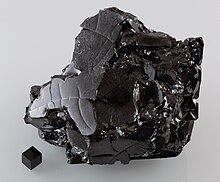Glass-like carbon, often called glassy carbon or vitreous carbon, is a non-graphitizing, or nongraphitizable, carbon which combines glassy and ceramic properties with those of graphite. The most important properties are high temperature resistance, hardness (7 Mohs), low density, low electrical resistance, low friction, low thermal resistance, extreme resistance to chemical attack and impermeability to gases and liquids. Glassy carbon is widely used as an electrode material in electrochemistry, for high temperature crucibles, and as a component of some prosthetic devices. It can be fabricated in different shapes, sizes and sections.
The names glassy carbon and vitreous carbon have been registered as trademarks, and IUPAC does not recommend their use as technical terms.[1]
Vitreous carbon can also be produced as a foam, called reticulated vitreous carbon (RVC). This foam was first developed in the mid to late 1960s as a thermally insulating, microporous glassy carbon electrode material. RVC foam is a strong, inert, electrically and thermally conductive, and corrosion-resistant porous form of carbon with a low resistance to gas and fluid flow. Due to these characteristics, the most widespread use of RVC in scientific work is as a three-dimensional electrode in electrochemistry.[2]Additionally, RVC foams are characterized by an exceptionally high void volume, high surface area, and very high thermal resistance in non-oxidising environments, which allows for heat sterilization and facilitates manipulation in biological applications.
https://en.wikipedia.org/wiki/Glassy_carbon


No comments:
Post a Comment